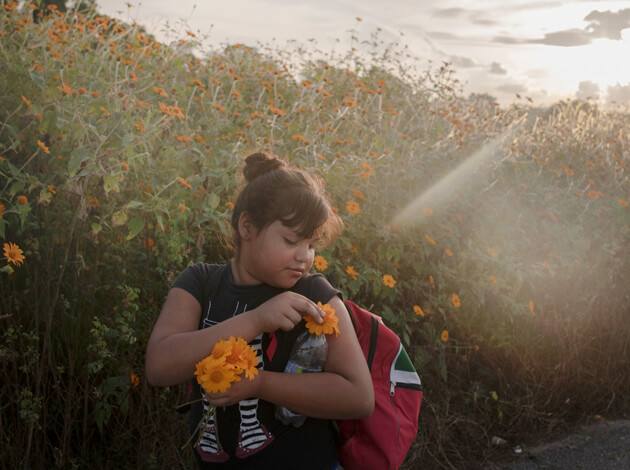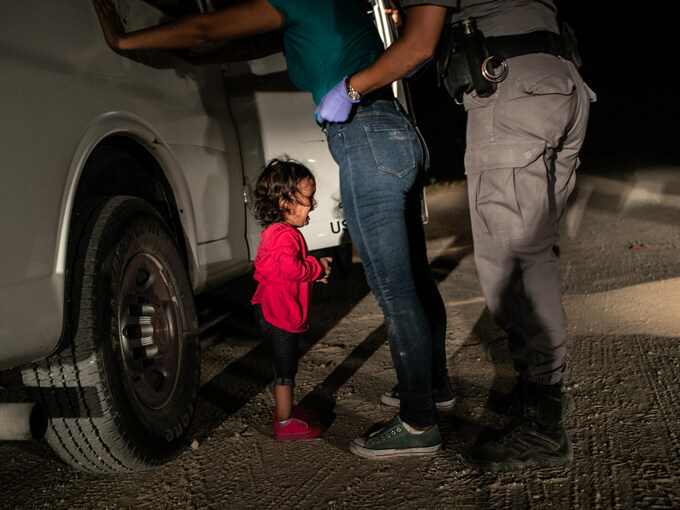Jul 17, 2019 Art
What does a legacy event like the World Press Photo Exhibition offer in a digital-first world?
Not to be dramatic, but I’m starting to worry about the state of my soul. As a journalist I spend an unhealthy amount of time online, especially on Twitter, where images of children in cages and photos of babies’ bodies washed ashore from the Mediterranean sea or along the banks of the Rio Grande enter and just as quickly exit my field of vision while I scroll aimlessly. There’s no context for their presence (I just wanted to look at memes), no limit to the number of times they might appear on my screen, totally unbidden.
To use glib media-speak, it’s becoming harder and harder for these images, these stories, to get cut through in my psyche, especially when they’re sandwiched between spicy or contrary takes in an endless scroll of never-ending news, most of it awful and difficult to comprehend, let alone know what to do about.
My ability to empathise feels in a way deadened. And I wondered what the World Press Photo Exhibition could offer now I’ve seen half the images already, often more than once, often accompanied by scolding captions asking some irritating variation of “why is no one talking about this?!” which makes me hate whoever wrote it and hardens my heart against whatever is depicted, which is both unfair and impossible not to do.
READ MORE: Dear Metro: “I’m terrified of my best friend dying”
READ MORE: Why are there so few films about female friendship?

I walk into the wooden-floored room on level six of Smith & Caughey’s, get my arm stamped by the retiree manning the desk and turn my phone to airplane mode. Untether myself from the distraction I’m otherwise powerless to resist, let my brain come into focus, and will myself to feel.
Three panels in and I’m laughing quietly. Hey, wasn’t this supposed to be meaningful and poignant? But the exhibition is about lightness too – a woman disguised as a man so she can watch a soccer game in Tehran (technically not funny I guess, but she looks unreal, like a beautiful Snapchat gender-swapped man, and I admire her chutzpah). A photo of a former Colombian guerilla gazing adoringly at his chubby baby girl – there’s been a post-conflict baby boom since FARC guerillas and the Colombian government agreed to a ceasefire in mid-2017.
In fact there are plenty of images I’ve never seen before, including a self portrait by Russian photographer Alyona Kochetkova unable to face a bowl of borscht (her favourite) while undergoing chemotherapy, her bald head bent low in defeat.
Of course, I’ve seen the World Press Photo of the Year winner many times before. The photo, shot by John Moore, shows Sandra Sanchez and her daughter stopped at the border on their way up from Honduras as they try to enter the United States. It’s the kind of photo I most worried no longer affected me: one which is in the news enough it becomes shorthand for a large scale atrocity, which is then knocked out of the new cycle as another terrible thing comes to light and then it’s gone from your brain like a dream vanishing as you slip from sleep to wakefulness. What was that about again?
I was halfway through the exhibition when I saw a series of photos about Ireland voting to repeal their eighth amendment last year, making abortion legal. I spent an afternoon sobbing in my kitchen as Irish women posted photos of themselves flying home to vote, and remembering Savita Halappanavar, who died in 2012 because she was denied the abortion which would have saved her life. Then I apparently completely discarded any memory of that ever happening; just another piece of news to be forgotten.
Up close the photo of the crying toddler comes into focus, the pink of her hoodie, the dark expanse of night receding back into the photo’s frame, how alone she looks. Her mother’s hands are pushed up onto a border patrol car, unable to comfort her. She looks not unlike my sister at that age: chubby cheeks and olive skin. Soft curls like my brother had as a baby – my mum cried when they were cut. The little girl’s mouth is drawn back in a terrified sob and I feel panicked, tears prick my eyes and luckily it’s a Thursday morning so pretty much no one else is there to see.
My phone is the first thing I look at when I wake up and the last thing I see before I go to bed, and in the hours in between I sometimes worry my mind doesn’t get a single moment of rest. There’s always news to read or a meme to look at or some podcast to listen to (a moratorium on podcasts, please). My hand will reflexively grab at my phone if heaven forbid I should let my mind wander for a moment as I walk to work or nip to the loo (sad to report I take my phone with me there too, a disgusting habit I know but let he who is without sin etc).
I’m constantly denying myself the space to figure out what I actually think about something – in case I get it wrong, I guess. When we’re collectively and immediately experiencing complex and deeply upsetting events via the unforgiving terrain of social media, the invisible pressure to quickly come up with the “right” response is a good incentive to outsource critical thinking to people you’re sure have smarter opinions than you do.

But it means you get lazy. Some crucial link is severed; you jump straight to the conclusion without really knowing how you got there, and suffering begins to glide off an ever-icier heart or so it can seem.
Inside the exhibition room, phone disabled, the amount of content available to me shrank and in tandem my capacity to properly absorb what I was looking at expanded. Making out the coarse hairs on the belly of a guanaco in Patagonia as a mountain lion hunts it down, tiny blades of tussock in the air showing the movement and the tussle, I could appreciate the photo was its own tiny world, anchored in time (between an animal, hunk of grass still in its mouth, quietly eating, and its death just beyond the frame), not part of the endless present of online. A house of ghosts in Guerrero, Mexico, shows where people should be but aren’t: underneath a bed’s canopy, or in a room full of petals following the funeral of a murdered man. Their absence makes you ache for the family left for years to wonder what happened to the relative who “disappeared”.
It’s such a relief to realise you’re still hanging on to the most human parts of yourself. That sometimes all they need is a little room to breathe.
The World Press Photo Exhibition is on until July 28, at Smith & Caughey’s, 253-261 Queens Street. Check the website for opening hours and more details.






